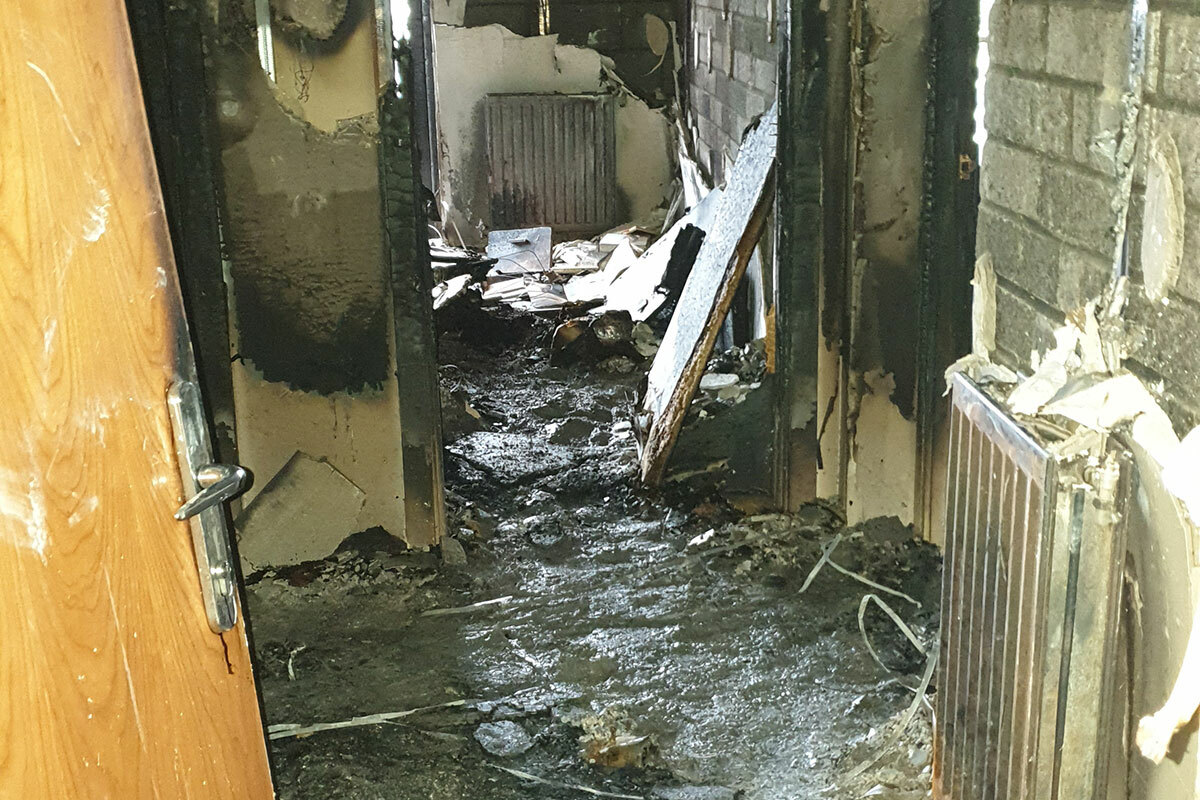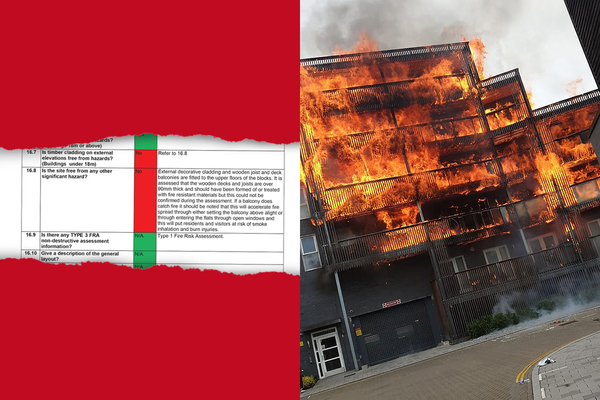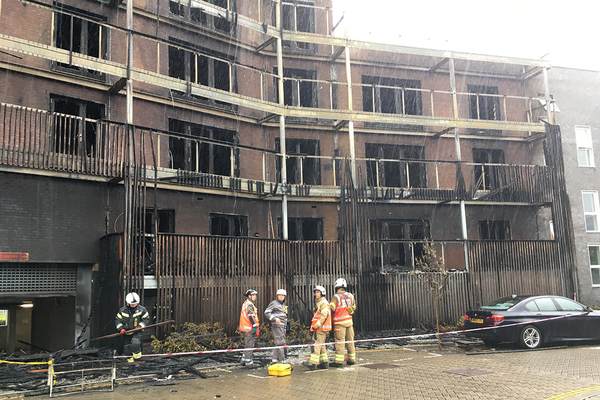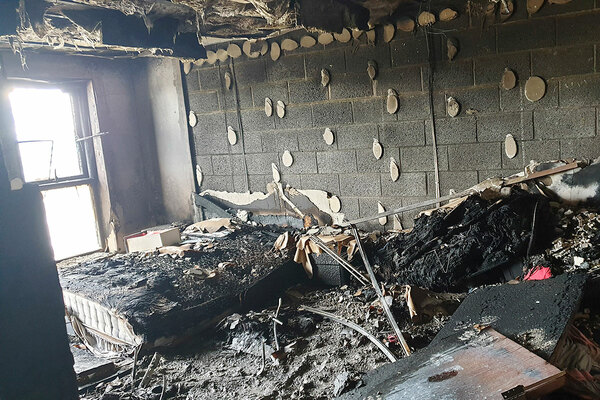You are viewing 1 of your 1 free articles
Chaos, confusion and miscommunication: five key takeaways from the Barking Fire review
A review into the devastating fire at the Samuel Garside block in Barking has been completed, highlighting a number of issues in the response to the fire and how buildings are managed more widely. Here Jack Simpson looks at the key takeaways from the review
When a fire broke out at the Samuel Garside block in east London’s Barking Riverside development on a hot Sunday afternoon in June 2019, it took just a matter of minutes for the flames to engulf the homes. Fuelled by the timber balconies and cladding that wrapped the building, the fire resulted in a mass evacuation and destroyed eight homes while damaging dozens more.
It was lucky that nobody was killed. However, many lives were turned upside down, not only by the trauma of the event but as a result of months of living in temporary accommodation, as their badly damaged homes took longer than expected to be brought back to a habitable state.
As this fire was one of the most significant post-Grenfell residential fires, the London Borough of Barking and Dagenham Council (LBBD) decided to launch a review to learn lessons on how best to deal with incidents like the devastating fire in the future. Led by Steve Bullock, former Lewisham mayor, and Diarmaid Ward, cabinet member for housing at Islington Council, it set out to dig into how the council, building owners and other stakeholders responded to the fire and provide recommendations for changes that might help, should a similar incident happen.
Here Inside Housing pores through the report to pick out the five key takeaways.
Response was stymied by complex ownership structures
To say that the ownership and management of the Samuel Garside block was complicated, would be an understatement. To briefly explain, the ownership structure goes as follows.
Barking Riverside Ltd, a joint venture between L&Q and the Greater London Authority, sold the land to Bellway under a 999-year lease agreement. Bellway built the development, then put the ownership under one of its subsidiary companies, Bellway XI Ltd. This head lease was then transferred onto Adriatic Land 3, one of the numerous subsidiaries of the £1.6bn Long Harbour Ground Rent Fund, which owns freeholds across the country and collects ground rents from leaseholders. Adriatic Land handed over responsibility for managing its ground rent interest to one of its sister companies HomeGround. They initially appointed Pinnacle as the building’s property manager, who were then replaced in 2018 by RMG, the property management arm of Places for People. To add another player into the mix, Southern Housing also owned and managed a number of social housing flats in the outer Samuel Garside blocks.
The report suggests the trauma and frustration by residents was exacerbated by the complex ownership structures. In short, none of the leaseholders knew who was responsible for what and where to get answers from.
The report suggests that on many occasions after the fire there was pure confusion over which body or organisation was responsible for their well-being and rehousing in the immediate aftermath. Residents often turned to the council for support and information, even though it wasn’t strictly their responsibility.
After the fire there were a number of instances where HomeGround, Adriatic Land, Bellway and RMG all seemed to shirk responsibility, with the council picking up the slack. In a resident’s meeting on the Monday, the council director for community solutions had to chair it because there was an absence of leadership from other stakeholders. In feedback for the report, Samuel Garside residents said it would have been easier with one source of information and one accountable body.
When reviewing the communication skills of RMG, Bellway and HomeGround, one resident described them as: “Unhelpful and not at all sympathetic, they didn’t care at all, very defensive and argumentative as well.”
However, the ownership of Samuel Garside is not uncommon, and an increasing number of private blocks are supported by these complex myriads of developers, freeholders, management companies and head lessees.
As part of the recommendations put forward by the review, the authors suggested that there should be a statement of ownership for multi-occupancy buildings that is sent to the Land Registry, which sets out the organisations which own the freehold and head leases, and also indicate which companies have ownership of these blocks. In the case of Adriatic Land, there are dozens of different companies holding variations of the name that own freeholds of buildings across the country and it is often unclear who to contact.
The review also says that individual leaseholders should receive an annual statement of ownership with the Land Registry setting out which organisation holds the freehold and sub-leases and contacts for each body and include references to responsibilities in an emergency like the Barking fire.
Mixed bag on housing association performance
As discussed earlier, there were a number of housing association stakeholders involved in the Samuel Garside blocks, of differing intensity. Southern Housing was the landlord for a number of homes in the outside blocks – blocks A and B. These were left undamaged by the fire, with blocks C and D bearing the brunt of the flames.
L&Q is the freeholder of the Barking Riverside land and owns more than 50% of the whole Barking Riverside site, and RMG, owned by Places for People, managed the Samuel Garside blocks.
In the immediate aftermath of the fire, residents were full of praise for Southern. The review notes that most found them very professional and helpful, and they were able to quickly arrange hotels for those affected. On the evening of the fire, 11 Southern Housing staff members were present at the Barking Fire recovery centre, and as a result all Southern Housing residents were housed that night. They also made sure that residents had all of the essentials for the short term.
Conversely, the reports of RMG in the immediate aftermath were not as complimentary. Only two RMG representatives were present at the recovery centre on the night of the fire, and as the situation moved from emergency to recovery phase, this was reduced to just one person. On the Tuesday, the council felt that this RMG operative was struggling and could not provide answers to the residents’ questions. RMG said in a submission to the review that, “usually there is no specific role for the managing agent until the property has been reinstated and re-occupied”.
The review also pointed out that compared to the complex ownership structures for private residents, which left leaseholders confused, in the case of Southern Housing tenants, all residents knew who was responsible for the evacuation and rehousing and had a central point of contact.
However, the review was not as positive about all of the aspects of the long-term rehousing efforts by the social landlords involved. It credited L&Q for making temporary housing available for displaced residents but said that many Southern Housing residents felt pressured to return to their homes despite feeling unsafe. The timber that was a major cause for the rapid fire spread was still present on the blocks. It should be noted on the issue of the wooden cladding and decking being removed, as the head lessee Southern had no responsibility or control over this.
There were several Southern Housing residents interviewed for the review who said that they did not feel comfortable going back to the block until the wood panelling was removed, while some also raised issues about the alarm system not being adequate.
One tenant said she felt forced to return to the property despite not feeling safe. She was offered another property, but the rent was higher than at Samuel Garside and it was a long way from her children’s school. She states that she could not afford the increase in rent and therefore felt she had no choice but to move back into Samuel Garside House as requested.
The rehousing effort left people in desperate situations
While the incident on 9 June was devastating and traumatic for those that lived in Samuel Garside, the re-housing effort which dragged on for months afterwards further exacerbated residents’ feeling of frustration and abandonment.
The report says that finding the displaced permanent accommodation while their homes were fixed was one of the greatest concerns, and many leaseholders were often left confused and concerned by the process.
In the aftermath of the fire, those with the most damaged homes were promised a move-back date 24 weeks after the fire took place, with others being given eight and 12-week slots. However, for most, the date in which they returned to their homes was well after the dates originally given, with some residents not returning home until the following March.
The report points to three key areas in which the re-housing effort failed, which were: a lack of clarity on the building safety works; lack of information about remedial works; and lack of information about when households could return home.
According to the report, the authors found no evidence that residents had been given a proper timetable for remediation and there wasn’t a co-ordinated plan to keep residents informed. Understandably many of those who had seen their homes or neighbours’ homes go up in flames, largely due to the presence of wooden cladding, were concerned about returning until the wood was removed. However, while the review praises Bellway for taking on the work despite not having any legal position with regards to the building, this work still took a number of months and residents were left in the dark. For those who did return earlier, some complained that the remedial work had been done to a low standard, while others said they were moved back when disruptive construction work was taking place.
Many of the residents also complained about a major lack of support from stakeholders such as HomeGround and the insurance company it used to help with the rehousing effort, the Insurance Claims Accommodation Bureau (ICAB). In many cases residents said that they were encouraged to seek their own alternative accommodation by ICAB, while others complained that even when they had found alternative accommodation, the process for getting that signed off by ICAB was cumbersome and saw them miss out on properties. One resident also complained that they had to continue to pay service charge on their Samuel Garside property, despite not having moved back at the time of the interview in June 2020.
The report suggests that in the future the question of who is responsible for the rehousing effort should be set out in the proposed statement of responsibilities, and that in cases where councils feel that the building owners or managers aren’t doing a good enough job, they can take over these roles under a new Housing Emergency Act.
The Barking fire and rehousing deeply affected a lot of people
While fortunately nobody died as a result of the fire, the impact on people’s mental health has been devastating and that is highlighted in the review. Sometimes it is easy to forget this in the melee of confusion that people are picking up the pieces of their lives.
One resident said: “We are still feeling the aftermath of the fire and this will never go away. We lost our home and everything in it and will never get anything back[…] We will never recover from what happened and that our flat was completely destroyed by the fire and the fear that we could have lost our lives will haunt us always.
In another excerpt from a Southern Housing resident, they said that after initially moving back into the block they had to move out again after the children were too scared to live in the property where they had witnessed the fire, with the woman’s son unable to enter the building’s lift due to the trauma.
There were also complaints that the lack of effective communication compounded all of this, with residents having to make calls every day to secure temporary accommodation, which felt like a second job. One resident said the whole process left her on the edge of a nervous breakdown.
At the time of the fire, developer Bellway didn’t have a central communications team but has since appointed a group communications director.
HomeGround said: “In some cases, communications could have been clearer and more responsive. This is a matter we have been reviewing with RMG throughout, in order to improve procedures in the event of a similar incident response being required in the future.”
However it also said that the amount they made from the Samuel Garside had to be put into perspective. It said: "To put expectations regarding the financial and other resource-focused response on the part of HomeGround into context, the only income the landlord receives from the leaseholders at SGH is the annual ground rent payable by the 47 private leaseholders, currently totalling just over £13,150 annually.
"At the time of the SGH fire each private leaseholder’s ground rent amounted to £200 or £250 annually, depending upon the size of their apartment."
Responses from Samuel Garside stakeholders
Bellway spokesperson: "Bellway acknowledges the Independent review into the fire at Samuel Garside House, a review that we have fully participated in. We echo the sentiments expressed in the report, that lessons should rightfully be learnt from the fire – which is why Bellway has continued to review and appraise own approach to fire safety, and we continue to embed these learnings within Group wide training and informing best practices.
"The report acknowledges that despite this being an historic development where we had no legal interest or management role, Bellway responded immediately upon notification of the fire, joining with all stakeholders including LFB, LB Barking & Dagenham, BRL, RMG, and Adriatic & Southern Housing Group the building’s owners to assist the leaseholders.
"Immediately after the fire, Bellway ensured interim safety measures were put in place, commenced repairs to fire damaged parts without delay and implemented a long term plan to improve fire safety including replacement balconies, all these works that are now complete. These works have gone significantly above and beyond any legal responsibility and have been funded jointly by Bellway, Buildings Insurers and SHG at no cost to residents."
Suzanne Horsley, Director of Building Safety at Southern Housing Group, said: “We are pleased that the report recognises the work of our dedicated colleagues in quickly ensuring that our residents were properly supported from the moment of evacuation. We know how difficult the decision to return to homes in Barking Riverside has been for some, even with the LFB’s assurance that it was safe to do so.
"As an organisation, the safety and wellbeing of our residents is our highest priority. While it would not be appropriate for us to comment on the individual circumstances, we have continued to work closely with all affected residents to reassure them and support their individual needs.
"This includes offers of permanent alternative accommodation for anyone who did not wish to return for any reason, offering all affected residents a range of options based on their circumstances and the available housing stock.
“We welcome the review’s recommendations as a way of helping us to ensure we are providing the best possible service for our residents. We will continue to work closely with all stakeholders on steps to reduce the risk of similar incidents in the future.”
Darren Rodwell, Leader of Barking and Dagenham Council, who commissioned the independent review, said: “While our focus on the day of the fire was working with the emergency services to get those residents to safety and ensure they had somewhere to sleep that night, it soon became clear that we had to act over and above our duties to get answers for our residents.
“Our council is often the fourth emergency service in a crisis and on this occasion, we were the only organisation able to provide overall coordination and leadership. This just isn’t sustainable weeks and months after an incident, unless we have the resources and powers to act. The response to the fire from our local community was overwhelming, but we cannot rely on goodwill alone to get us through an incident like that again – the Government need to listen to these recommendations and reform legislation.”
Inside Housing has contacted HomeGround and RMG.
Sign up for our fire safety newsletter
Already have an account? Click here to manage your newsletters





